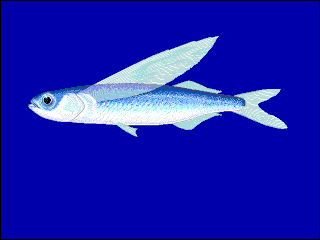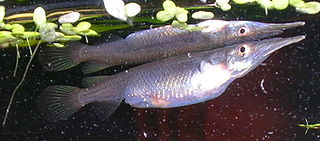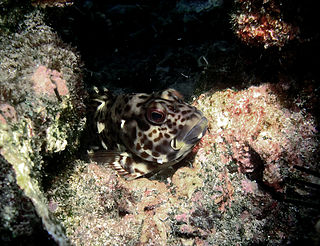
Cyprinodontiformes is an order of ray-finned fish, comprising mostly small, freshwater fish. Many popular aquarium fish, such as killifish and live-bearers, are included. They are closely related to the Atheriniformes and are occasionally included with them. A colloquial term for the order as a whole is toothcarps, though they are not actually close relatives of the true carps – the latter belong to the superorder Ostariophysi, while the toothcarps are Acanthopterygii.

The Scorpaeniformes are a diverse order of ray-finned fish, including the lionfishes and sculpins, but have also been called the Scleroparei. It is one of the five largest orders of bony fishes by number of species, with over 1,320.

Cypriniformes is an order of ray-finned fish, which includes many families and genera of cyprinid fish, such as barbs, gobies, loaches, botias, and minnows. Cypriniformes is an “order-within-an-order”, placed under the superorder Ostariophysi—which is also made up of cyprinid, ostariophysin fishes. The order contains 11-12 families, over 400 genera, and more than 4,250 named species; new species are regularly described, and new genera are recognized frequently. Cyprinids are most diverse in South and Southeast Asia, but are entirely absent from Australia and South America. At 112 years old, the longest-lived cypriniform fish documented is the bigmouth buffalo.
Hemiramphidae is a family of fishes that are commonly called halfbeaks, spipe fish or spipefish. They are a geographically widespread and numerically abundant family of epipelagic fish inhabiting warm waters around the world. The halfbeaks are named for their distinctive jaws, in which the lower jaws are significantly longer than the upper jaws. The similar viviparous halfbeaks have often been included in this family.

Cirrhitidae, the hawkfishes, are a family of marine perciform ray-finned fishes found in tropical seas and which are associated with coral reefs.

Beloniformes is an order composed of six families of freshwater and marine ray-finned fish:

Scorpaenoidei is a suborder of ray-finned fishes, part of the order Scorpaeniformes, that includes the scorpionfishes, lionfishes and velvetfishes. This suborder is at its most diverse in the Pacific and Indian Oceans but is also found in the Atlantic Ocean.

The superorder Elopomorpha contains a variety of types of fishes that range from typical silvery-colored species, such as the tarpons and ladyfishes of the Elopiformes and the bonefishes of the Albuliformes, to the long and slender, smooth-bodied eels of the Anguilliformes. The one characteristic uniting this group of fishes is they all have leptocephalus larvae, which are unique to the Elopomorpha. No other fishes have this type of larvae.

The Trichodontidae, or sandfishes, are a small family of ray-finned fishes from the order Scorpaeniformes. The species in this family are found in the North Pacific Ocean.

Macroramphosidae, the snipefishes and bellowsfishes is a family of oviparous, marine fish which form part of the superfamily Centriscoidea, which is one of the two superfamilies in the suborder Aulostomoidei of the order Syngnathiformes, which includes the seahorses, pipefishes, trumpetfishes and dragonets. It has been considered to be a subfamily of the Centriscidae but Nelson (2016) classified it as a family.

Hyporhamphus is a genus of halfbeaks. The species in this genus are distributed throughout the warmer seas of the world, most species being Indo-Pacific and there are some freshwater species.

Cottoidei is a suborder of ray-finned fishes which, according to the 5th edition of Fishes of the World, is placed within the order Scorpaeniformes, alongside the scorpionfishes, flatheads, eelpouts, sticklebacks and related fishes.

Zenarchopteridae, the viviparous halfbeaks, is a family in the order Beloniformes. The Zenarchopteridae exhibit strong sexual dimorphism, practicing internal fertilisation, and in some cases ovoviviparous or viviparous. The members in the family are mainly found in fresh and brackish water of tropical Asia and New Guinea, but the genus Zenarchopterus also includes marine species from the Indo-Pacific. Several, such as the wrestling halfbeak, have become commonly traded aquarium fish.

The Anabantiformes, collectively known as labyrinth fish, are an order of air-breathing freshwater ray-finned fish with two suborders, five families and having at least 207 species. In addition, some authorities expand the order to include the suborder Nandoidei, which includes three families - the Nandidae, Badidae and Pristolepididae - that appear to be closely related to the Anabantiformes. The order, and these three related families, are part of a monophyletic clade which is a sister clade to the Ovalentaria, the other orders in the clade being Synbranchiformes, Carangiformes, Istiophoriformes and Pleuronectiformes. This clade is sometimes referred to as the Carangaria but is left unnamed and unranked in Fishes of the World. This group of fish are found in Asia and Africa, with some species introduced in United States of America.

Ovalentaria is a clade of ray-finned fishes within the Percomorpha, referred to as a subseries. It is made up of a group of fish families which are referred to in Fishes of the World's fifth edition as incertae sedis, as well as the orders Mugiliformes, Cichliformes, and Blenniiformes. It was named by W. L. Smith and T. J. Near in Wainwright et al. (2012) based on a molecular phylogeny, but the authors suggested that the group was united by the presence of demersal eggs that are attached to a substrate. Some authors have used the ordinal name Stiassnyiformes for a clade including Mugiloidei, Plesiopidae, Blenniiformes, Atherinomorpha, and Cichlidae, and this grouping does appear to be monophyletic.

Scomberesocoidea is a superfamily within the suborder Exocoetoidei of the order Beloniformes. It consists of two families which are commonly known as the needlefishes and the sauries.

Exocoetoidea is a superfamily of fishes that comprises three families, the flying fishes, the halfbeaks and the viviparous halfbeaks. They are found in tropical and subtropical waters around the world. Exocoetoidea is part of the suborder Exocoetoidei of the order Beloniformes.

Aplocheiloidei is a suborder of the order Cyprinodontiformes consisting of three families which are commonly known as killifishes.

Cirrhitoidea is a superfamily within the suborder Percoidei of the large order of ray-finned fishes, the Perciformes.

Scorpaenini is a tribe of marine ray-finned fishes, one of two tribes in the subfamily Scorpaeninae. This tribe contains the "typical" or "true" scorpionfishes. The taxonomy of the scorpionfishes is in some flux, the 5th Edition of Fishes of the World treats this taxa as a tribe within the subfamily Scorpaeninae of the family Scorpaenidae within the order Scorpaeniformes, while other authorities treat it as a subfamily within a reduced family Scorpaenidae within the suborder Scorpaenoidei, or the superfamily Scorpaenoidea within the order Perciformes.



















